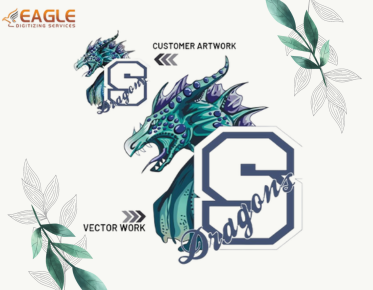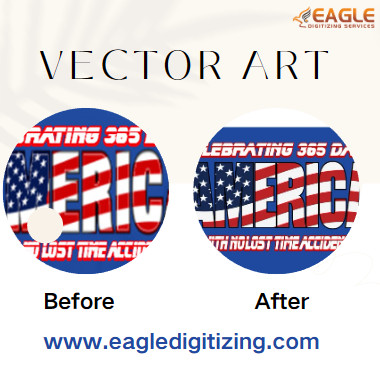Photoshop Stitch-Up: Intro to Digitizing Embroidery
Embroidery has long been a revered craft,
but with the advent of digital technology, its landscape is evolving. Enter
Photoshop, a versatile tool known for its prowess in digital imaging. But can
it be used for embroidery digitization? Let's
unravel this fascinating intersection and explore the potential of digitizing
embroidery in Photoshop.
Why Digitize Embroidery?
Embroidery digitization offers numerous
advantages, from increased precision and consistency to faster production
times. By digitizing embroidery designs,
artisans can streamline the creation process and achieve intricate detailing
that manual methods may struggle to replicate.
The Benefits of Digital Embroidery
Digital embroidery brings a host of
benefits, including the ability to store and reproduce designs with exacting
accuracy. This means fewer errors, less material wastage, and enhanced
efficiency in the production pipeline. Additionally, digital files can be
easily shared and modified, fostering collaboration and creativity.
Understanding the Basics of
Embroidery Digitization
What
is Embroidery Digitization?
Embroidery digitization is the process of
converting artwork into a format that can be read by an embroidery machine. This involves translating the design into a
series of instructions that dictate stitch types, densities, and colors. The
result is a digital file that guides the machine in recreating the design on
fabric.
The
Difference Between Manual and Digital Embroidery
Manual embroidery relies on skilled artisans to stitch designs by hand, a labor-intensive and time-consuming process. Digital embroidery, on the other hand, automates much of this work, using computerized machines to execute designs with precision and speed.
Can Photoshop Be Used for
Embroidery Digitization?
Photoshop, renowned for its image editing
capabilities, can indeed be utilized for embroidery digitization. While it may
not be as specialized as dedicated embroidery software,
Photoshop offers a range of tools and features that can aid in the digitization
process.
Exploring Photoshop's Capabilities
Limitations
of Photoshop in Embroidery Digitization
While Photoshop is a powerful tool, it does have limitations when it comes to embroidery digitization. Its primary function is image editing rather than embroidery-specific tasks, so users may encounter challenges when trying to execute complex embroidery designs.
Getting
Started with Photoshop for Embroidery
Setting Up Your Workspace
Customize your Photoshop workspace to
suit your embroidery digitization needs. Arrange panels and tools for easy
access, and create custom shortcuts to streamline your workflow.
Essential Tools and Features in
Photoshop
Familiarize yourself with essential tools
like the Pen Tool for creating precise paths, brushes for adding stitch
effects, and layer styles for enhancing depth and realism in your designs.
Preparing Your Design for
Digitization
Start by importing your design into Photoshop and cleaning it up as needed. Adjust resolution and size to ensure optimal quality for embroidery. Pay attention to details that may affect stitch density and clarity.
Creating Embroidery Patterns in
Photoshop
Using
the Pen Tool for Precise Paths
The Pen Tool is a staple for creating
intricate paths in Photoshop. Use it to trace the outlines of your design,
ensuring smooth curves and precise lines that translate well to embroidery
stitches.
Utilizing
Brushes for Stitch Effects
Photoshop offers a range of brushes that
mimic different stitch types. Experiment with brush settings to achieve the
desired stitch length, density, and texture. Layering different brush strokes
can create depth and dimension in your embroidery designs.
Applying
Textures to Mimic Embroidery
Enhance the realism of your embroidery
designs by adding texture layers. Use patterns or custom textures to simulate
fabric weaves and thread effects, giving your designs a tactile quality that
pops off the screen.
Color Management in Photoshop
Embroidery
Choosing
the Right Color Palette
Selecting the right color palette is
crucial for effective embroidery digitization. Consider factors like thread
availability and fabric color when choosing colors for your design. Create
custom swatches to maintain consistency across your project.
Layer
Management for Embroidery Designs
Organize your layers intelligently to
facilitate easy editing and manipulation of your embroidery designs. Use
folders and groupings to keep related elements together, making it simpler to
adjust individual components as needed.
Using
Layer Styles for Depth and Realism
Layer styles like bevels, shadows, and gradients can add depth and realism to your embroidery designs. Experiment with different effects to create lifelike textures and highlights that enhance the visual appeal of your artwork.
Advanced Techniques for Digitizing
Embroidery
Simulating
Stitch Types with Photoshop
Photoshop's versatility allows for the
simulation of various stitch types, from simple running stitches to intricate
satin stitches. Experiment with brush settings, layer styles, and blending
modes to achieve realistic stitch effects.
Creating
Embroidery Effects with Blending Modes
Blending modes offer endless
possibilities for enhancing embroidery designs in Photoshop. Overlaying layers
with different blending modes can create unique color combinations, textures,
and lighting effects that elevate your artwork.
Incorporating
Fabric Textures into Your Design
For added authenticity, incorporate
fabric textures into your embroidery designs. Use photos or custom patterns to
overlay fabric textures onto your artwork, creating a tactile feel that mirrors
the real-world embroidery process.
Exporting Your Design for Embroidery
Machines
Preparing
Files for Export
Before exporting your design, ensure it
meets the requirements of your embroidery machine. Simplify complex designs,
convert text to outlines, and rasterize effects as needed to ensure
compatibility.
Choosing
the Right File Format
Select a file format that is compatible
with your embroidery machine and preserves the integrity of your design. Common
formats include DST, EXP, and PES, each with its own advantages and
limitations.
Converting
Photoshop Designs for Embroidery Software
Photoshop designs may need to be converted to vector format for compatibility with embroidery software. Use vector tracing tools or export as SVG files before importing into dedicated embroidery software.
Common Challenges of Using Photoshop
for Digitizing Embroidery
Embroidery digitization using Photoshop
can be a rewarding endeavor, but it also comes with its fair share of
challenges. In this article, we'll explore some of the common obstacles faced
by designers when using Photoshop for digitizing embroidery and strategies to
overcome them.
Lack
of Specialized Tools for Embroidery Digitization
Photoshop, while a powerful tool for
image editing and design, lacks specialized features specifically tailored for
embroidery digitization. Designers may find themselves improvising with
existing tools, leading to inefficiencies and suboptimal results.
Difficulty
in Creating Stitch Patterns
One of the primary challenges in
embroidery digitization is translating intricate designs into stitch patterns.
Photoshop's tools are not inherently designed for this purpose, making it
challenging to achieve the level of detail and precision required for quality
embroidery.
Limited
Control Over Stitch Density and
Length
Controlling stitch density and length is
crucial for achieving desired embroidery effects and ensuring durability.
However, Photoshop offers limited control over these parameters, leaving
designers with less flexibility in adjusting stitch settings to meet their
requirements.
Managing
Color Transitions and Variations
Embroidery involves intricate color
transitions and variations to create lifelike designs. Photoshop's color
management capabilities may fall short of accurately representing these
nuances, leading to discrepancies between digital designs and embroidered outputs.
Complexity
in Converting Raster Images to Embroidery
Converting raster images to embroidery
requires careful consideration of factors such as image complexity, color
gradients, and stitch types. Photoshop's raster-based approach may complicate
this process, requiring additional steps and manual adjustments to ensure
optimal results.
Difficulty
in Simulating Embroidery Textures and Effects
Emulating textures and effects
characteristic of embroidery poses a significant challenge in Photoshop. While
filters and layer styles can simulate some aspects of embroidery, achieving
realistic results often requires a combination of digital manipulation and
manual stitching techniques.
Alternative Software for Embroidery
Digitization
Comparing
Photoshop with Dedicated Embroidery Software
While Photoshop offers robust capabilities
for embroidery digitization, dedicated embroidery software may provide
specialized tools and workflows tailored to the craft. Consider the specific
requirements of your project when choosing between Photoshop and dedicated
software.
Pros
and Cons of Using Specialized Tools
Specialized embroidery software offers
advanced features and automation options that streamline the digitization
process. However, it may have a steeper learning curve and limited flexibility
compared to Photoshop. Evaluate your needs and preferences to determine the
best tool for your project.
Trends in Digital Embroidery
The
Future of Embroidery Digitization
As technology advances, so too will the
capabilities of digital embroidery. Innovations in software, materials, and
techniques promise to push the boundaries of what is possible, opening up new
creative avenues for artists and designers.
Innovations
in Embroidery Software and Techniques
Embroidery software continues to evolve, with developers introducing new features and improvements to enhance the digitization process. Look out for advancements in automation, customization, and integration with other design tools.
Community and Resources
Online
Forums and Tutorials for Photoshop Embroidery
Join online forums and communities
dedicated to Photoshop embroidery to connect with fellow enthusiasts, share
tips and techniques, and seek advice on overcoming challenges in your projects.
Connecting
with Other Embroidery Enthusiasts
Networking with other embroidery
enthusiasts can provide valuable support and inspiration for your creative
endeavors. Attend workshops, conferences, and meetups to expand your knowledge
and forge connections within the embroidery community.
The Potential of Photoshop in
Embroidery Digitization
Photoshop offers a wealth of tools and
features that can facilitate embroidery digitization, from creating precise
paths to simulating stitch effects and textures. While it may not be as
specialized as dedicated embroidery software, Photoshop's versatility makes it
a valuable asset for artists looking to explore the intersection of digital
imaging and embroidery.
Ready to embark on your embroidery digitization journey? Dive into Photoshop's
capabilities, experiment with different techniques, and unleash your creativity
on the digital canvas. Whether you're a seasoned embroiderer or a newcomer to
the craft, Photoshop offers endless possibilities for bringing your embroidery
designs to life.



